

Kansas Lithic Material
| Name | Natural | Non-heat treated points | Heat treated points | Color details | Primary found in: | Associated Formation / Member |
| Aarde Shale |
 |
 |
Dull yellowish gray | Eastern Kansas | Aarden Shale Member of the Howard Limestone Formation | |
| Alibates Chert |
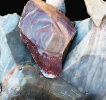 |
|
Mottled color from most commonly reds, yellows, and oranges in iron rich areas to blues and dark greens | Southwestern Kansas | Quartermaster Formation | |
| Arbuckle Chert |
 |
 |
 |
Oolitic and ranges from a tan to a light gray color. | Southeastern Kansas | Arbuckle Formation, Osage Group |
| Argentine Chert |
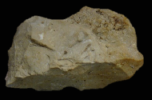 |
 |
 |
Ranges in color from a light tan to a pale to medium gray. Light mottling or streaking may be present. | Northeastern Kansas | Argentine Member of the Wyandotte Limestone Formation |
|
Baldy Hill Jasper AKA: Cimarron River Jasper |
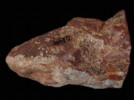 |
 |
Mottled color from most commonly varying shades of reds and yellows. | Southwestern Kansas | Baldy Hill Formation | |
| Blue River Agate |
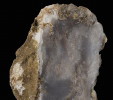 |
 |
Northeastern Kansas | Eskridge Formation | ||
| Blue Springs Chert |
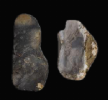 |
 |
 |
Northeastern Kansas | ||
| Blue Valley Agate |
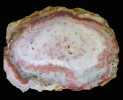 |
 |
White to light blue or pinkish matrix with pink bands or patches | Northeastern Kansas | Wreford Formation | |
|
Boone Chert AKA: Sallisaw Chert, Grand Falls Chert, Ti Valley Chert |
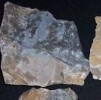 |
|
 |
Ranges from a light gray to white | Southeastern Kansas | Boone Limestone Formation |
| Cherokee Chert |
 |
 |
 |
Kansas | ||
| Cheyenne Quartzite |
 |
 |
Southern Kansas | Cheyenne Sandstone Formation | ||
|
Cottonwood Chert AKA: Manhattan Chert |
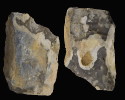 |
 |
 |
Grayish brown with patches of shades of white. | Northeastern Kansas | Cottonwood Limestone Formation |
|
Dakota Quartzite AKA: Dakota Orthoquartzite |
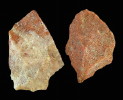 |
 |
Ranges in color from reds to browns | Western Kansas | Dakota Formation | |
| Day Creek Chert |
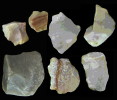 |
 |
 |
Ranges from a mottled very light pale blue to a grayish blue or a reddish blue. Tan and brown mottling or streaking may be present | Southwestern Kansas | Day Creek Dolomite Member of the Cloud Chief Formation |
| Ervine Creek Chert |
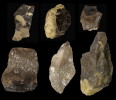 |
 |
 |
Ranges from a light medium gray to a dark gray. Larger white specks are formed by fossils | Northeastern Kansas | Ervine Creek Limestone Member, Deer Creek Limestone Formation |
|
Flint Hill Chert AKA fro Florence Chert type D |
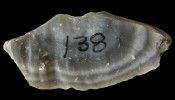 |
|
 |
Wide range of colors including shades of blue and gray, whites, and browns. | Central Kansas | Florence Limestone Member of the Barnestone Formation |
| Flint Hills Quartzite |
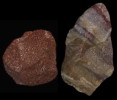 |
 |
Central Kansas | |||
|
Florence Chert - Type A AKA: Kay County Chert, Maple City Chert |
  |
|
 |
Banded or "wood grained" and ranges in color from a buff to a yellow gray. Heat treatment produces a red color. | Southern Kansas | Florence Limestone Member, Barnestone Formation, Permian Group |
| Florence Chert - Type B |
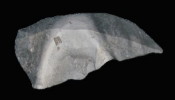 |
 |
 |
Ranges in color from a steel gray to a bluish gray with lighter colored splotches or darker colored mottling. | Southern Kansas | Florence Limestone Member, Barnestone Formation, Permian Group |
| Florence Chert - Type C |
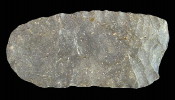 |
|
 |
Homogenous gray | Southern Kansas | Florence Limestone Member, Barnestone Formation, Permian Group |
|
Florence Chert - Type D AKA: Flint Hills Chert |
 |
|
 |
Ranges from gray to a buff with many thin bands of darker translucent material. | Southern Kansas | Florence Limestone Member, Barnestone Formation, Permian |
|
Foraker Chert AKA: Four Ace Chert |
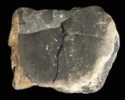 |
  |
 |
Light blue color with numerous snow white speckles of fossils. | Kansas, Oklahoma, Arkansas | Foraker Limestone Formation |
|
Fort Scott Chert AKA: Bixby Black Chert |
 |
 |
 |
Ranges from a dark bluish black to black. | Oklahoma, Arkansas, Kansas, Missouri | Fort Scott Limestone Formation, Henrietta (Marmaton) Group |
| Gilmore City Chert |
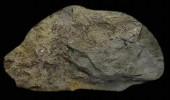 |
 |
Opaque brownish gray | Northeastern Kansas | Gilmore City Formation | |
|
Grand Falls Chert Boone Chert variation |
 |
 |
 |
Light gray color and may vary to brown | Southeastern Kansas | Grand Falls Member of the Boone Formation |
| Hunton Chert |
 |
 |
 |
North central Kansas | Hunton Limestone Formation | |
| Kansas Pipestone |
 |
  |
Homogenous medium red color | Kansas | ||
| Keokuk Chert |
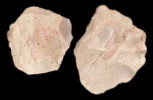 |
 |
 |
Ranges from a creamy white to a whitish pink with streaks or patches of whitish brown or whitish pink and reddish spots commonly present. | Missouri, Kansas, Arkansas, Oklahoma | Keokuk Formation of the St. Joes Group |
|
Luta Chert AKA: Marion Chert, Winfield Chert |
 |
 |
 |
Banded chert | East central Kansas | Luta Limestone Member of the Winfield Formation |
|
Nehawka Chert Rice Grain Chert, Protozoa Agate, Weeping Water Chert |
 |
 |
Ranges from grayish blue to blue with oolitic white specks | Northeastern Kansas | Pennsylvanian Limestone Formation | |
| Neva Chert |
 |
 |
 |
White | Central Kansas | Neva Limestone Member of the Grenola Formation |
|
Ogallala
Orthoquartzite AKA: Bijou Hills Silicified Sediment and Sugar Rock |
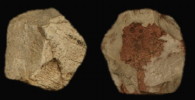 |
 |
 |
Colors can vary, but most common colors are light to dark gray, tan, white, pink, maroon, or golden | Western Kansas | Ogallala Formation |
|
Ogallala Palm Wood AKA: Petrified Palmwood |
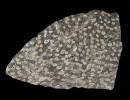 |
 |
Ranges from white to a dark gray with specks. | Western Kansas | Ogallala Formation | |
|
Ogallala Silicified
Sediment AKA: Ogallala Chert |
 |
 |
 |
Ranges from a buff to a reddish color or gray. Quartz inclusions form speckles in the material. | Western Kansas | Ogallala Formation |
|
Osage Chert Osage Undifferentiated Chert |
 |
 |
 |
Ranges from a white to light gray or light brown. Occasionally gray to dark gray mottling is present. | Eastern Kansas | Osage Series |
|
Peoria Chert AKA: Tahlequah Chert |
 |
  |
|
Primarily white but ranges to a pale yellowish what to a yellowish brown or pink | Southeastern Kansas | Tahlequah Member of the Moorefield Formation |
|
Petrified Wood AKA: Agatized Wood, Opalized Wood |
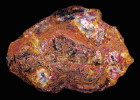 |
 |
Vary in color based on the minerals present during the process | Kansas | Varies | |
| Plattsburg Chert |
 |
 |
 |
Light brown color. | Northeastern Kansas | Plattsburg Limestone Formation |
|
Reed's Spring Chert AKA: Carr Branch Chert |
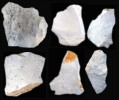 |
 |
 |
Opaque chert ranging in color from a bluish gray to a light gray or yellowish brown. | Southeastern Kansas | Reed's Springs formation |
|
Republican River Jasper AKA for Smoky Hills Jasper |
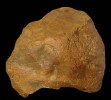 |
 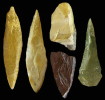 |
Vary in color from a mustard brown or caramel brown to a chalky or creamy white, less commonly red, green, or black does occur, Inclusions and dendrites may be present | North central Kansas | Smoky Hills Member of the Niobrara Chalk Formation | |
| Rhyolite |
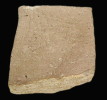 |
  |
Gray to grayish black, flow banding may be present alternating from light to darker gray | Kansas | Volcanic Activity | |
|
Schroyer Chert AKA: Wreford Type B |
 |
 |
 |
Ranges from bluish gray to a gray and may be mottled or splotched with darker gray with speckles of small white fossils | Central Kansas | Schroyer Member, Wrenford Limestone Formation |
|
Smoky Hills Jasper AKA: Alma, Graham, Niobrara, Republican River Jasper |
 |
  |
Vary in color from a mustard brown or caramel brown to a chalky or creamy white, less commonly red, green, or black does occur, Inclusions and dendrites may be present | North central Kansas | ||
| South Bend Chert |
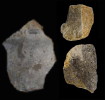 |
 |
 |
Ranges from a light gray to a light bluish gray, concretions are commonly present. | Northeastern Kansas | South Bend Limestone Member of the Stanton Limestone Formation |
| Spring Hill Chert |
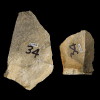 |
 |
 |
Strongly mottled and ranges from light to dark gray with dark speckles being present. | Northeastern Kansas | Spring Hill Member, Plattsburg Limestone Formation |
|
Stoner Chert Type A and B |
 |
 |
 |
Ranges from light to medium gray or a grayish tan with white veins. | Northeastern Kansas | Stoner Member of the Stanton Formation, Lansing Group |
|
Three Mile Chert Wreford Chert Variant AKA: Wreford Chert type A |
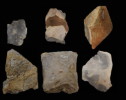 |
 |
 |
Yellowish brown | Southeastern Kansas | Threemile Limestone Member, Wreford Limestone Formation, Permian Group |
| Toronto Chert |
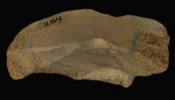 |
|
 |
Homogenous ranging from a white to a pale brown or yellowish brown. | Northeastern Kansas | Toronto Limestone Member, Oread Formation of the Shawnee Group |
|
Tuff AKA: Solidified Volcanic Ash |
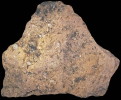 |
 |
Contains greater than 75 volcanic ash and ranges from white to tan, gray or pink. | Kansas | Volcanic activity | |
| Westerville Chert |
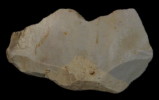 |
 |
 |
Ranges from homogeneous to mottled pale brown to a light yellowish brown or brownish yellow with thin bands may be present. | Northeastern Kansas | Westerville Limestone Member of the Cherryvale Shale Formation |
|
Winterset Chert AKA: Fusulinid Chert, Zebra Chert |
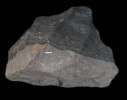 |
|
 |
Primarily homogenous, ranging to mottled or layered, ranging from a light to dark gray or brownish gray, opaque may have a "zebra" appearance | Northeastern Kansas | Winterset Limestone Member of the Dennis Limestone Formation, Kansas City Group |
| Wreford Chert |
 |
 |
 |
Ranges from a buff to tan or grayish tan to a bluish gray to gray. Mottling or banding may be present. | Central Kansas | Wreford Limestone Formation |